engine coolant CADILLAC ATS 2019 User Guide
[x] Cancel search | Manufacturer: CADILLAC, Model Year: 2019, Model line: ATS, Model: CADILLAC ATS 2019Pages: 384, PDF Size: 6.11 MB
Page 259 of 384
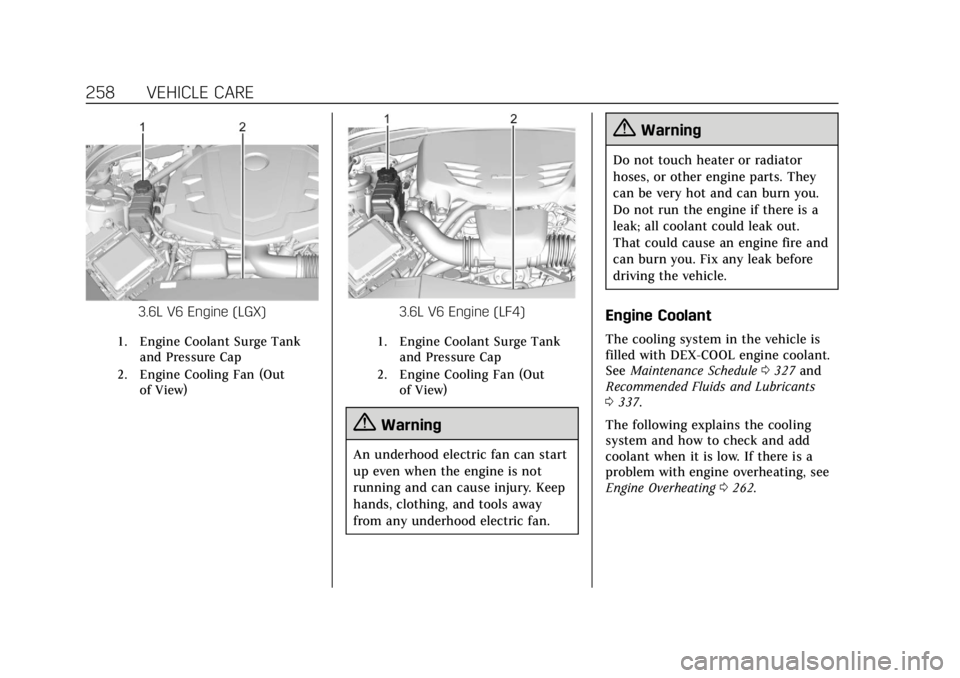
Cadillac ATS/ATS-V Owner Manual (GMNA-Localizing-U.S./Canada/Mexico-
12460272) - 2019 - crc - 5/8/18
258 VEHICLE CARE
3.6L V6 Engine (LGX)
1. Engine Coolant Surge Tankand Pressure Cap
2. Engine Cooling Fan (Out of View)
3.6L V6 Engine (LF4)
1. Engine Coolant Surge Tank
and Pressure Cap
2. Engine Cooling Fan (Out of View)
{Warning
An underhood electric fan can start
up even when the engine is not
running and can cause injury. Keep
hands, clothing, and tools away
from any underhood electric fan.
{Warning
Do not touch heater or radiator
hoses, or other engine parts. They
can be very hot and can burn you.
Do not run the engine if there is a
leak; all coolant could leak out.
That could cause an engine fire and
can burn you. Fix any leak before
driving the vehicle.
Engine Coolant
The cooling system in the vehicle is
filled with DEX-COOL engine coolant.
See Maintenance Schedule 0327 and
Recommended Fluids and Lubricants
0 337.
The following explains the cooling
system and how to check and add
coolant when it is low. If there is a
problem with engine overheating, see
Engine Overheating 0262.
Page 260 of 384

Cadillac ATS/ATS-V Owner Manual (GMNA-Localizing-U.S./Canada/Mexico-
12460272) - 2019 - crc - 5/8/18
VEHICLE CARE 259
What to Use
{Warning
Do not touch heater or radiator
hoses, or other engine parts. They
can be very hot and can burn you.
Do not run the engine if there is a
leak; all coolant could leak out.
That could cause an engine fire and
can burn you. Fix any leak before
driving the vehicle.
Use a 50/50 mixture of clean
drinkable water and DEX-COOL
coolant. This mixture:
. Gives freezing protection down to
−37 °C (−34 °F), outside
temperature.
. Gives boiling protection up to
129 °C (265 °F), engine
temperature.
. Protects against rust and
corrosion.
. Will not damage aluminum parts.
. Helps keep the proper engine
temperature.
Caution
Do not use anything other than a
mix of DEX-COOL coolant that
meets GM Standard GMW3420 and
clean, drinkable water. Anything
else can cause damage to the
engine cooling system and the
vehicle, which would not be covered
by the vehicle warranty.
Never dispose of engine coolant by
putting it in the trash, pouring it on
the ground, or into sewers, streams,
or bodies of water. Have the coolant
changed by an authorized service
center, familiar with legal
requirements regarding used coolant
disposal. This will help protect the
environment and your health.
Checking Coolant
The vehicle must be on a level surface
when checking the coolant level. It is normal to see coolant moving in
the upper coolant hose return line
when the engine is running. It is also
normal to see bubbles entering the
surge tank through the small hose.
Check to see if coolant is visible in the
coolant surge tank. If the coolant
inside the coolant surge tank is
boiling, do not do anything else until
it cools down.If coolant is visible but the coolant
level is not at or above the cold fill
line, add a 50/50 mixture of clean
drinkable water and DEX-COOL
coolant.
Page 261 of 384
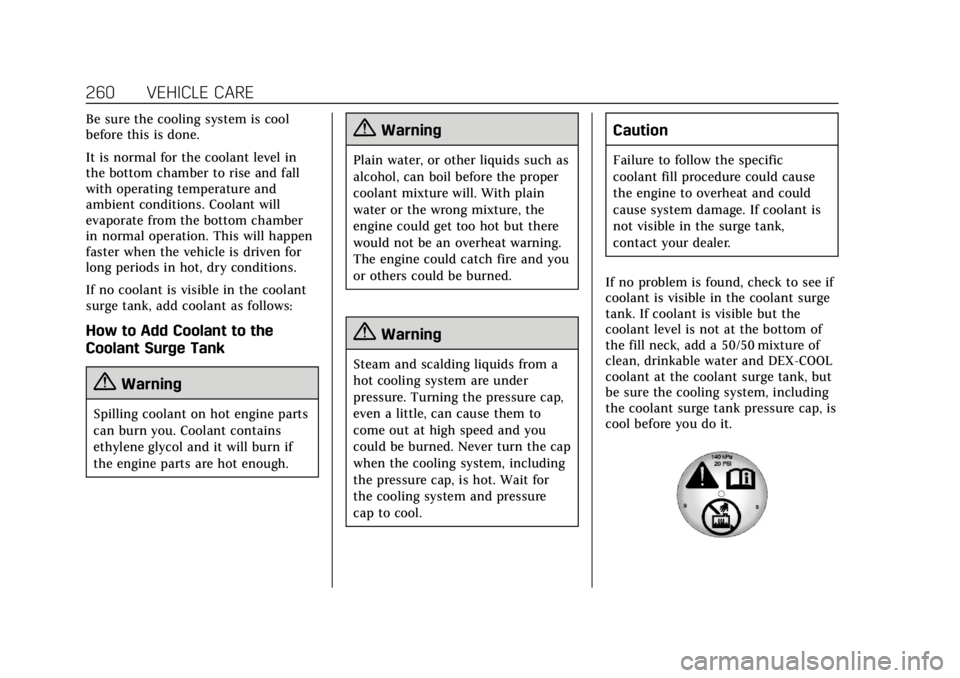
Cadillac ATS/ATS-V Owner Manual (GMNA-Localizing-U.S./Canada/Mexico-
12460272) - 2019 - crc - 5/8/18
260 VEHICLE CARE
Be sure the cooling system is cool
before this is done.
It is normal for the coolant level in
the bottom chamber to rise and fall
with operating temperature and
ambient conditions. Coolant will
evaporate from the bottom chamber
in normal operation. This will happen
faster when the vehicle is driven for
long periods in hot, dry conditions.
If no coolant is visible in the coolant
surge tank, add coolant as follows:
How to Add Coolant to the
Coolant Surge Tank
{Warning
Spilling coolant on hot engine parts
can burn you. Coolant contains
ethylene glycol and it will burn if
the engine parts are hot enough.
{Warning
Plain water, or other liquids such as
alcohol, can boil before the proper
coolant mixture will. With plain
water or the wrong mixture, the
engine could get too hot but there
would not be an overheat warning.
The engine could catch fire and you
or others could be burned.
{Warning
Steam and scalding liquids from a
hot cooling system are under
pressure. Turning the pressure cap,
even a little, can cause them to
come out at high speed and you
could be burned. Never turn the cap
when the cooling system, including
the pressure cap, is hot. Wait for
the cooling system and pressure
cap to cool.
Caution
Failure to follow the specific
coolant fill procedure could cause
the engine to overheat and could
cause system damage. If coolant is
not visible in the surge tank,
contact your dealer.
If no problem is found, check to see if
coolant is visible in the coolant surge
tank. If coolant is visible but the
coolant level is not at the bottom of
the fill neck, add a 50/50 mixture of
clean, drinkable water and DEX-COOL
coolant at the coolant surge tank, but
be sure the cooling system, including
the coolant surge tank pressure cap, is
cool before you do it.
Page 262 of 384
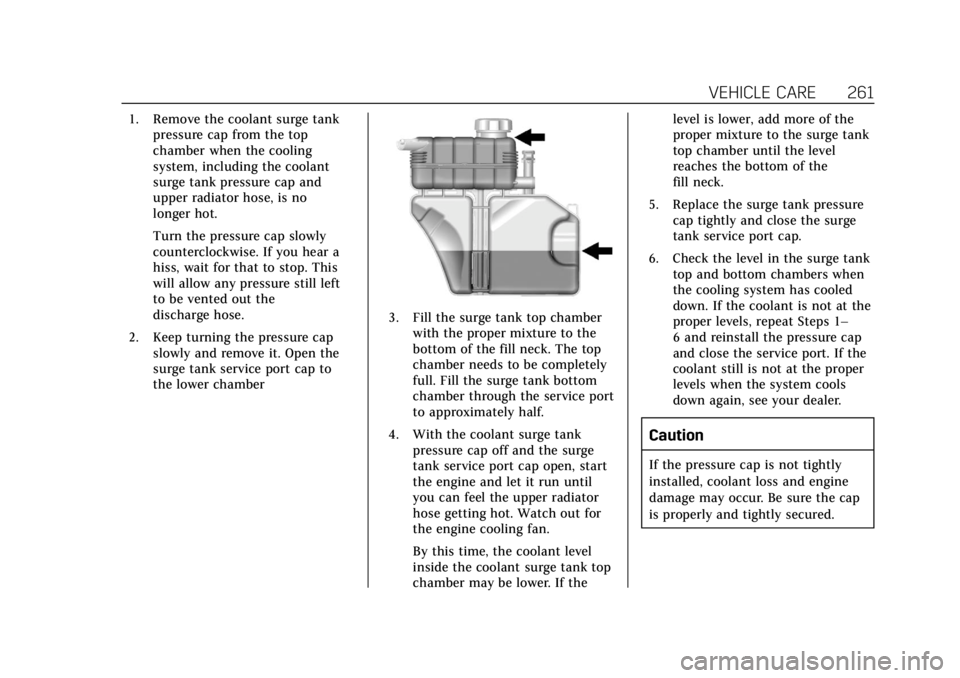
Cadillac ATS/ATS-V Owner Manual (GMNA-Localizing-U.S./Canada/Mexico-
12460272) - 2019 - crc - 5/8/18
VEHICLE CARE 261
1. Remove the coolant surge tankpressure cap from the top
chamber when the cooling
system, including the coolant
surge tank pressure cap and
upper radiator hose, is no
longer hot.
Turn the pressure cap slowly
counterclockwise. If you hear a
hiss, wait for that to stop. This
will allow any pressure still left
to be vented out the
discharge hose.
2. Keep turning the pressure cap slowly and remove it. Open the
surge tank service port cap to
the lower chamber
3. Fill the surge tank top chamberwith the proper mixture to the
bottom of the fill neck. The top
chamber needs to be completely
full. Fill the surge tank bottom
chamber through the service port
to approximately half.
4. With the coolant surge tank pressure cap off and the surge
tank service port cap open, start
the engine and let it run until
you can feel the upper radiator
hose getting hot. Watch out for
the engine cooling fan.
By this time, the coolant level
inside the coolant surge tank top
chamber may be lower. If the level is lower, add more of the
proper mixture to the surge tank
top chamber until the level
reaches the bottom of the
fill neck.
5. Replace the surge tank pressure cap tightly and close the surge
tank service port cap.
6. Check the level in the surge tank top and bottom chambers when
the cooling system has cooled
down. If the coolant is not at the
proper levels, repeat Steps 1–
6 and reinstall the pressure cap
and close the service port. If the
coolant still is not at the proper
levels when the system cools
down again, see your dealer.
Caution
If the pressure cap is not tightly
installed, coolant loss and engine
damage may occur. Be sure the cap
is properly and tightly secured.
Page 263 of 384
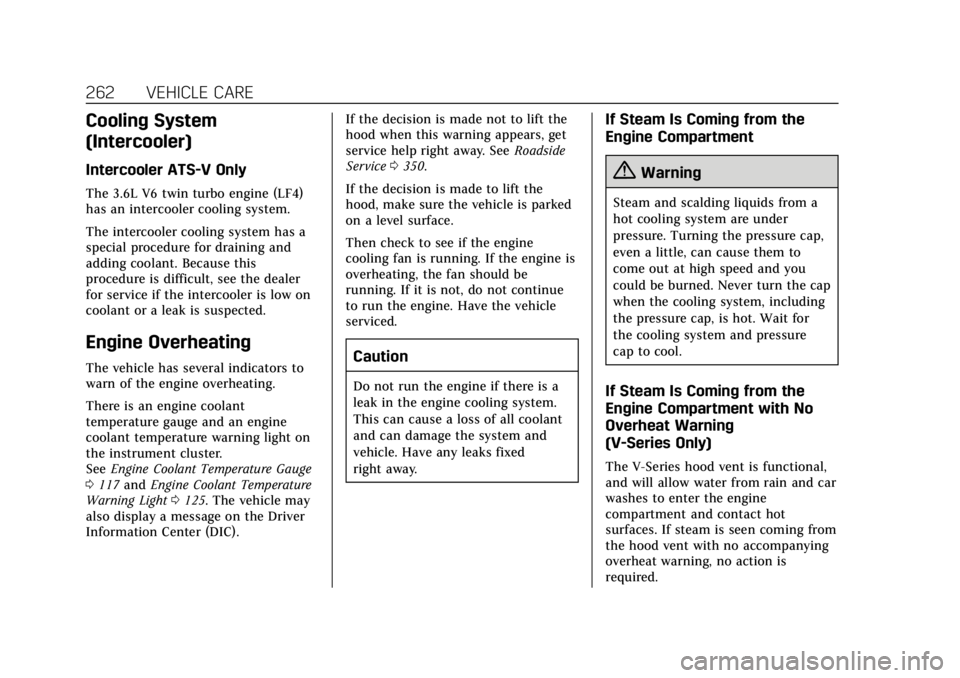
Cadillac ATS/ATS-V Owner Manual (GMNA-Localizing-U.S./Canada/Mexico-
12460272) - 2019 - crc - 5/8/18
262 VEHICLE CARE
Cooling System
(Intercooler)
Intercooler ATS-V Only
The 3.6L V6 twin turbo engine (LF4)
has an intercooler cooling system.
The intercooler cooling system has a
special procedure for draining and
adding coolant. Because this
procedure is difficult, see the dealer
for service if the intercooler is low on
coolant or a leak is suspected.
Engine Overheating
The vehicle has several indicators to
warn of the engine overheating.
There is an engine coolant
temperature gauge and an engine
coolant temperature warning light on
the instrument cluster.
SeeEngine Coolant Temperature Gauge
0 117 and Engine Coolant Temperature
Warning Light 0125. The vehicle may
also display a message on the Driver
Information Center (DIC). If the decision is made not to lift the
hood when this warning appears, get
service help right away. See
Roadside
Service 0350.
If the decision is made to lift the
hood, make sure the vehicle is parked
on a level surface.
Then check to see if the engine
cooling fan is running. If the engine is
overheating, the fan should be
running. If it is not, do not continue
to run the engine. Have the vehicle
serviced.Caution
Do not run the engine if there is a
leak in the engine cooling system.
This can cause a loss of all coolant
and can damage the system and
vehicle. Have any leaks fixed
right away.
If Steam Is Coming from the
Engine Compartment
{Warning
Steam and scalding liquids from a
hot cooling system are under
pressure. Turning the pressure cap,
even a little, can cause them to
come out at high speed and you
could be burned. Never turn the cap
when the cooling system, including
the pressure cap, is hot. Wait for
the cooling system and pressure
cap to cool.
If Steam Is Coming from the
Engine Compartment with No
Overheat Warning
(V-Series Only)
The V-Series hood vent is functional,
and will allow water from rain and car
washes to enter the engine
compartment and contact hot
surfaces. If steam is seen coming from
the hood vent with no accompanying
overheat warning, no action is
required.
Page 264 of 384

Cadillac ATS/ATS-V Owner Manual (GMNA-Localizing-U.S./Canada/Mexico-
12460272) - 2019 - crc - 5/8/18
VEHICLE CARE 263
If No Steam Is Coming from the
Engine Compartment
If an engine overheat warning is
displayed but no steam can be seen or
heard, the problem may not be too
serious. Sometimes the engine can get
a little too hot when the vehicle:
.Climbs a long hill on a hot day.
. Stops after high-speed driving.
. Idles for long periods in traffic.
If the overheat warning is displayed
with no sign of steam: 1. Turn the air conditioning off.
2. Turn the heater on to the highest temperature and to the highest
fan speed. Open the windows as
necessary.
3. When it is safe to do so, pull off the road, shift to P (Park) or
N (Neutral) for an automatic
transmission or Neutral for a
manual transmission, and let the
engine idle.
If the engine coolant temperature
gauge is no longer in the overheated
area or the engine coolant temperature warning light no longer
displays, the vehicle can be driven.
Continue to drive the vehicle slowly
for about 10 minutes. Keep a safe
distance from the vehicle in front.
If the warning does not come back on,
continue to drive normally and have
the cooling system checked for proper
fill and function.
If the warning continues, pull over,
stop, and park the vehicle right away.
If there is no sign of steam, idle the
engine for three minutes while parked.
If the warning is still displayed, turn
off the engine until it cools down.
Washer Fluid
What to Use
When windshield washer fluid is
needed, be sure to read the
manufacturer's instructions before
use. If operating the vehicle in an area
where the temperature may fall below
freezing, use a fluid that has sufficient
protection against freezing.
Adding Washer Fluid
Open the cap with the washer symbol
on it. Add washer fluid until the tank
is full. See
Engine Compartment
Overview 0246 for reservoir location.
Caution
.
Do not use washer fluid that
contains any type of water
repellent coating. This can
cause the wiper blades to
chatter or skip.
. Do not use engine coolant
(antifreeze) in the windshield
washer. It can damage the
windshield washer system
and paint.
(Continued)
Page 278 of 384
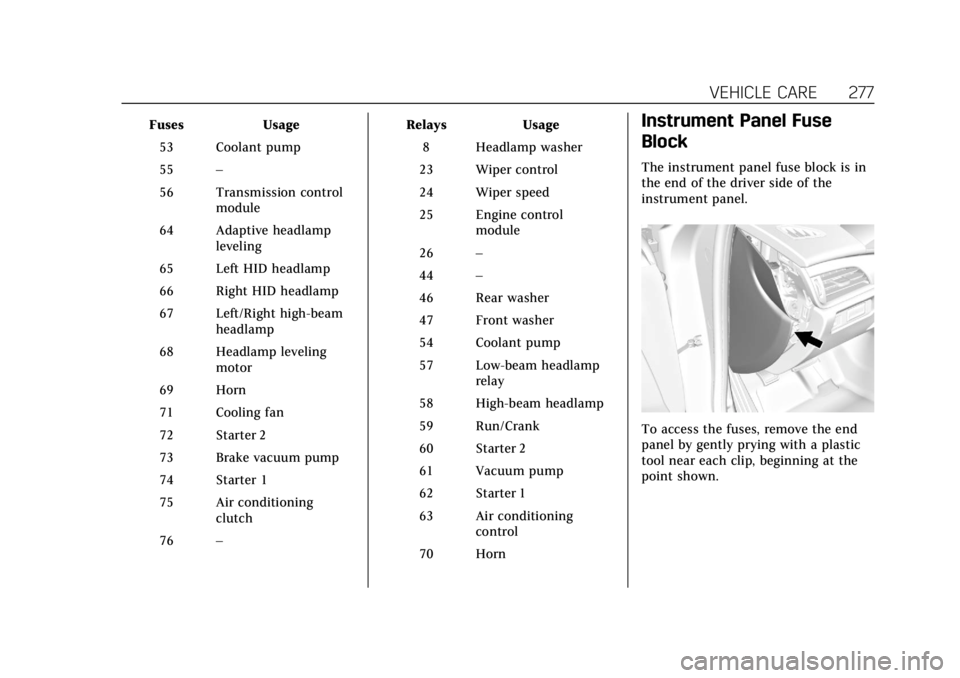
Cadillac ATS/ATS-V Owner Manual (GMNA-Localizing-U.S./Canada/Mexico-
12460272) - 2019 - crc - 5/8/18
VEHICLE CARE 277
FusesUsage
53 Coolant pump
55 –
56 Transmission control module
64 Adaptive headlamp leveling
65 Left HID headlamp
66 Right HID headlamp
67 Left/Right high-beam headlamp
68 Headlamp leveling motor
69 Horn
71 Cooling fan
72 Starter 2
73 Brake vacuum pump
74 Starter 1
75 Air conditioning clutch
76 – Relays
Usage
8 Headlamp washer
23 Wiper control
24 Wiper speed
25 Engine control module
26 –
44 –
46 Rear washer
47 Front washer
54 Coolant pump
57 Low-beam headlamp relay
58 High-beam headlamp
59 Run/Crank
60 Starter 2
61 Vacuum pump
62 Starter 1
63 Air conditioning control
70 HornInstrument Panel Fuse
Block
The instrument panel fuse block is in
the end of the driver side of the
instrument panel.
To access the fuses, remove the end
panel by gently prying with a plastic
tool near each clip, beginning at the
point shown.
Page 329 of 384

Cadillac ATS/ATS-V Owner Manual (GMNA-Localizing-U.S./Canada/Mexico-
12460272) - 2019 - crc - 5/8/18
328 SERVICE AND MAINTENANCE
is reset accidentally, service the
vehicle within 5 000 km/3,000 mi since
the last service. Reset the oil life
system when the oil is changed. See
Engine Oil Life System0253.
Air Conditioning Desiccant
(Replace Every Seven Years)
The air conditioning system requires
maintenance every seven years. This
service requires replacement of the
desiccant to help the longevity and
efficient operation of the air
conditioning system. This service can
be complex. See your dealer.
Tire Rotation and Required
Services Every 12 000 km/
7,500 mi
Rotate the tires, if recommended for
the vehicle, and perform the following
services. See Tire Rotation0295.
. Check engine oil level and oil
life percentage. If needed, change
engine oil and filter, and reset oil
life system.
See Engine Oil 0251 and Engine Oil
Life System 0253. .
Check engine coolant level.
See Cooling System (Engine) 0257
or Cooling System (Intercooler)
0 262.
. Check windshield washer fluid
level. See Washer Fluid 0263.
. Check tire inflation pressures. See
Tire Pressure 0289.
. Inspect tire wear. See Tire
Inspection 0295.
. Visually check for fluid leaks.
. Inspect engine air cleaner filter.
See Engine Air Cleaner/Filter 0256.
. Inspect brake system. See Exterior
Care 0318.
. Visually inspect steering,
suspension, and chassis
components for damage, including
cracks or tears in the rubber boots,
loose or missing parts, or signs of
wear at least once a year. See
Exterior Care 0318.
. Inspect power steering for proper
attachment, connections, binding,
leaks, cracks, chafing, etc. .
Visually inspect halfshafts and
drive shafts for excessive wear,
lubricant leaks, and/or damage
including: tube dents or cracks,
constant velocity joint or universal
joint looseness, cracked or missing
boots, loose or missing boot
clamps, center bearing excessive
looseness, loose or missing
fasteners, and axle seal leaks.
. Check restraint system
components. See Safety System
Check 070.
. Visually inspect fuel system for
damage or leaks.
. Visually inspect exhaust system
and nearby heat shields for loose
or damaged parts.
. Lubricate body components. See
Exterior Care 0318.
. Check starter switch. See Starter
Switch Check 0268.
. Check automatic transmission
shift lock control function. See
Automatic Transmission Shift Lock
Control Function Check 0268.
Page 338 of 384

Cadillac ATS/ATS-V Owner Manual (GMNA-Localizing-U.S./Canada/Mexico-
12460272) - 2019 - crc - 5/8/18
SERVICE AND MAINTENANCE 337
Recommended Fluids, Lubricants, and Parts
Recommended Fluids and Lubricants
UsageFluid/Lubricant
Automatic Transmission DEXRON-HP Automatic Transmission Fluid. Chassis Lubrication Chassis Lubricant (GM Part No. 12377985, in Canada 88901242) or lubricant
meeting requirements of NLGI #2, Category LB or GC-LB.
Engine Coolant 50/50 mixture of clean, drinkable water and use only DEX-COOL Coolant.
See Cooling System (Engine) 0257 orCooling System (Intercooler) 0262.
Engine Oil Engine oil meeting the dexos1 specification of the proper SAE viscosity grade.
ACDelco dexos1 full synthetic is recommended. See Engine Oil0251.
Electronic Limited-Slip Differential (eLSD) Hydraulic Apply Fluid (V-Series Only) DEXRON-VI Automatic Transmission Fluid.
Hood Latch Assembly, Secondary Latch,
Pivots, Spring Anchor, and Release Pawl Lubriplate Lubricant Aerosol (GM Part No. 89021668, in Canada 89021674) or
lubricant meeting requirements of NLGI #2, Category LB or GC-LB.
Hydraulic Brake/Clutch System DOT 3 Hydraulic Brake Fluid (GM Part No. 19353126, in Canada 19353127).
Key Lock Cylinders, Hood and Door Hinges Multi-Purpose Lubricant, Superlube (GM Part No. 12346241, in
Canada 10953474).
Manual Transmission (Except ATS-V) DEXRON-VI Automatic Transmission Fluid. Manual Transmission (ATS-V) Manual Transmission Fluid (GM Part No. 88861800, in Canada 88861801).
Rear Axle/Front Axle (All-Wheel Drive) Gear DEXRON MTF 75W-90 (GM Part No. 88863089, in Canada 88863090).
Page 375 of 384

Cadillac ATS/ATS-V Owner Manual (GMNA-Localizing-U.S./Canada/Mexico-
12460272) - 2019 - crc - 5/8/18
374 INDEX
CompartmentsStorage . . . . . . . . . . . . . . . . . . . . . . . . . . . . 101
Compass . . . . . . . . . . . . . . . . . . . . . . . . . . . . . 108
Competitive Driving Mode . . . . . . . . . 209
Composite Materials . . . . . . . . . . . . . . . . 185
Compressor Kit, Tire Sealant . . . . . . . 304
Connected Services Connections . . . . . . . . . . . . . . . . . . . . . . . 369
Diagnostics . . . . . . . . . . . . . . . . . . . . . . . . 371
Navigation . . . . . . . . . . . . . . . . . . . . . . . . . 368
Connections
Connected Services . . . . . . . . . . . . . . . 369
Control Traction and ElectronicStability . . . . . . . . . . . . . . . . . . . . . . . . . . 204
Control of a Vehicle . . . . . . . . . . . . . . . . 171
Convex Mirrors . . . . . . . . . . . . . . . . . . . . . . 45
Coolant
Engine Temperature Gauge . . . . . . 117
Engine Temperature WarningLight . . . . . . . . . . . . . . . . . . . . . . . . . . . . . 125
Cooling . . . . . . . . . . . . . . . . . . . . . . . . .158, 162
Cooling System . . . . . . . . . . . . . . . .257, 262
Courtesy Lamps . . . . . . . . . . . . . . . . . . . . . 149
Courtesy Transportation Program . . . . . . . . . . . . . . . . . . . . . . . . . . . . 352
Cruise Control . . . . . . . . . . . . . . . . . . . . . . . 213 Light . . . . . . . . . . . . . . . . . . . . . . . . . . . . . . . 128 Cruise Control, Adaptive . . . . . . . . . . . 215
Cupholders . . . . . . . . . . . . . . . . . . . . . . . . . . 102
Customer Assistance . . . . . . . . . . . . . . . 348
Offices . . . . . . . . . . . . . . . . . . . . . . . . . . . . . 348
Text Telephone (TTY) Users . . . . . 348
Customer Information Publications Ordering
Information . . . . . . . . . . . . . . . . . . . . . . 355
Customer Satisfaction Procedure . . . . . . . . . . . . . . . . . . . . . . . . . . 346
D
Damage Repair, Collision . . . . . . . . . . . 353
Danger, Warning, and Caution . . . . . . . . 3
Data CollectionInfotainment System . . . . . . . . . . . . . 359
OnStar . . . . . . . . . . . . . . . . . . . . . . . . . . . . . 358
Data Recorder Performance . . . . . . . . . . . . . . . . . . . . . . . 152
Data Recorders, Event . . . . . . . . . . . . . . 357
Daytime Running Lamps (DRL) . . . 146
Defensive Driving . . . . . . . . . . . . . . . . . . . 171
Delayed Locking . . . . . . . . . . . . . . . . . . . . . 39
Diagnostics Connected Services . . . . . . . . . . . . . . . 371
Distracted Driving . . . . . . . . . . . . . . . . . . 170
Dome Lamps . . . . . . . . . . . . . . . . . . . . . . . . 149 Door
Ajar Light . . . . . . . . . . . . . . . . . . . . . . . . . 128
Delayed Locking . . . . . . . . . . . . . . . . . . . . 39
Locks . . . . . . . . . . . . . . . . . . . . . . . . . . . . . . . . 37
Power Locks . . . . . . . . . . . . . . . . . . . . . . . . . 39
Drive Belt Routing, Engine . . . . . . . . . 345
Drive Systems All-Wheel Drive . . . . . . . . . . . . . . 200, 267
Driver Assistance Systems . . . . . . . . . 223
Driver Information Center (DIC) . . . . . . . . . . . . . . . . . . . . . . . 128
Driver Mode Control . . . . . . . . . . . . . . . . 205
Driving Assistance Systems . . . . . . . . . . . . . . . 228
Competitive . . . . . . . . . . . . . . . . . . . . . . . 209
Defensive . . . . . . . . . . . . . . . . . . . . . . . . . . 171
Drunk . . . . . . . . . . . . . . . . . . . . . . . . . . . . . . 171
For Better Fuel Economy . . . . . . . . . . . 26
Hill and Mountain Roads . . . . . . . . 179
If the Vehicle is Stuck . . . . . . . . . . . . 181
Loss of Control . . . . . . . . . . . . . . . . . . . . 173
Off-Road Recovery . . . . . . . . . . . . . . . . 172
Track Events and Competitive . . . 173
Vehicle Load Limits . . . . . . . . . . . . . . 181
Wet Roads . . . . . . . . . . . . . . . . . . . . . . . . . 178
Winter . . . . . . . . . . . . . . . . . . . . . . . . . . . . . 179
Dual Automatic Climate Control System . . . . . . . . . . . . . . .158, 162